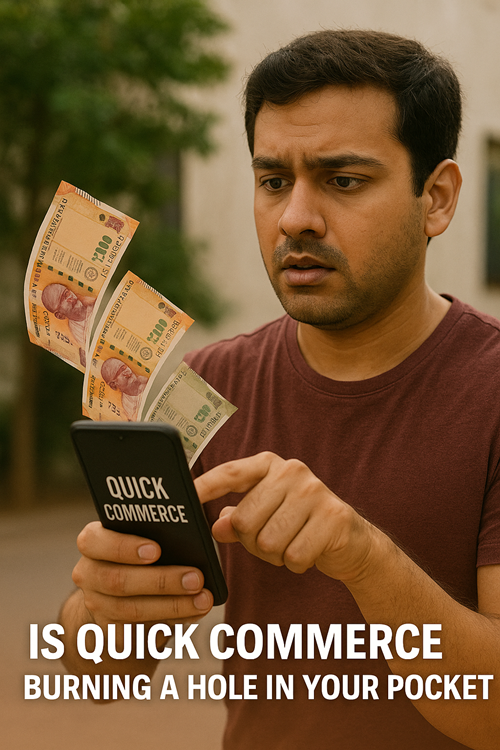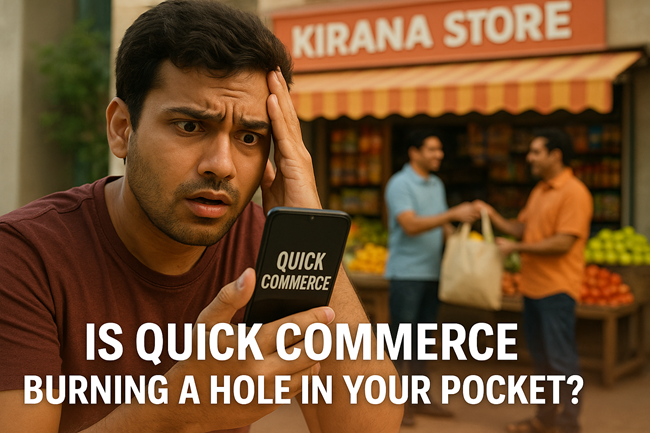Quick Commerce vs Kirana Stores Comparison:
The Rise of the 10-Minute Lifestyle
In the fast-paced urban chaos of Indian cities, quick commerce apps like Zepto, Blinkit, and Instamart promised a magical solution — groceries, snacks, toiletries everything you need at your doorstep in just 10 minutes. For millions of millennials, working professionals, and even homemakers, it was love at first click.
A few months ago, I couldn’t imagine a day without Zepto, Blinkit, or Instamart. From groceries to last-minute Maggi cravings, everything landed at my doorstep in under 10 minutes. I felt like I had unlocked a new level of convenience. But now? I’m walking back to my nearby kirana store — and honestly, it’s the best thing I’ve done for my wallet, my health, and even my peace of mind.
But now, as 2025 unfolds, the honeymoon period seems to be ending. From soaring costs to vanishing discounts, consumers are waking up to the hidden price of this “instant convenience.”
Let me explain why this shift made complete sense for me, and why many others are feeling the same way.
The 10-Minute Magic — That Slowly Stopped Making Sense
When these quick commerce apps first came into the picture, I was hooked. The offers were tempting — ₹100 off, flat ₹49 combos, free delivery. It felt like a tech-powered grocery utopia.
I began ordering the smallest things — a single pack of bread, one packet of chips, even coriander leaves — just because I could.
But slowly, things began to change.
Reality Check: The Hidden Costs That Started Adding Up
I started noticing that my monthly grocery bill was shooting up. Initially, I thought it was inflation. But when I compared prices between my local kirana store and the quick commerce apps, the difference was huge.
- ₹5–₹10 extra on every basic vegetable
- ₹15–₹25 delivery fee on smaller orders
- ₹3–₹5 platform fee (they sneak this one in)
- ₹3–₹10 for packaging, even for non-fragile stuff
When I added it up, I realized I was spending almost ₹1,500–₹2,000 extra every month on things that I could’ve easily walked out and bought.

Delayed Deliveries, Missing Items & No Accountability
What frustrated me even more were the missed timelines and incomplete orders. I’d wait 20–25 minutes only to find that the bread I needed wasn’t delivered, or the fruits were half-rotten.
And when I tried to return or report it? A chatbot. No human to help. No refund until they “review.” Most times, I just gave up.
Freshness You Can See vs. Freshness You Have to Trust
Let’s talk about vegetables and fruits. I don’t know how many times I got:
- Mushy tomatoes
- Green bananas that stayed raw for 5 days
- Soggy coriander with brown edges
In contrast, at my local kirana, I see, touch, and pick what I want. I can ask the shopkeeper to hand me the freshest batch. If something doesn’t look good, I skip it — simple.
No surprises when I open a bag at home.
The Human Touch: Something Apps Can’t Replace
One of the biggest differences I’ve felt after going back to my kirana store is personal connection.
- They remember my preferences
- They remind me when new stock comes
- They give me extra green chilies or coriander for free
- And yes, they offer credit when I forget my wallet
This kind of service just doesn’t exist with any app. There’s no algorithm for warmth and trust.
Ease of Returns: No App Can Match It
The other day I bought rice from the kirana store that turned out to have a slight odor. I went back the next morning, and he replaced the entire bag. No questions asked. No receipt needed.
Try doing that on a quick commerce app. You’ll be stuck in a loop of FAQs and “waiting for investigation.”
Bulk Buying Is Just Cheaper Offline
Dal, atta, oil — these essentials are still much more affordable in bulk from your local store. The price difference isn’t small when you’re buying 5kg or 10kg packs.
On the apps, these items are overpriced, and they rarely go on discount anymore.
The Discounts Disappeared, But the Charges Didn’t
When these apps launched, they spoiled us. Freebies, coupons, cashback, and whatnot.
Today?
- Offers are only on large baskets (₹999 or more)
- No more cashback
- First-time user coupons are a one-time thing
- Loyalty passes give minimal value now
In short: The freebies are gone, but the fees are here to stay.
Here’s What I Found After Switching Back to Kirana Stores
Better Prices
Essentials are 10–25% cheaper. No hidden charges. No surge pricing.
Flexible Quantities
Want ₹10 worth of turmeric or one green chili? You get it. No minimum value, no packaging charges.
Personal Experience
The shopkeeper gives you suggestions, reminds you of what you might’ve forgotten, and helps carry heavy bags if needed.
Fresher Stock
Especially with vegetables and dairy — the difference is noticeable.
Trust
If something goes wrong, I just go and speak. It gets resolved.
So, Are Quick Commerce Apps Useless?
Not at all. They still come in handy for:
- Urgent midnight cravings
- Emergency items
- Rainy days when stepping out is tough
But for regular groceries, my vote now goes to the humble kirana shop. The kind of savings, quality, and service I get there — no app has matched so far.
Quick Commerce vs Kirana Stores : FAQs
1. Are local kirana stores really cheaper than Zepto or Blinkit?
Yes. On average, I save ₹5–₹20 per item. Over a month, it easily adds up to ₹800–₹1,000 in savings.
2. What about convenience? Isn’t ordering from apps easier?
It is convenient, but only when it works perfectly. Late deliveries, missing items, and high charges make it less convenient than it seems.
3. What happens if I want to return something from a kirana store?
It’s simple — just walk back and return. Most shopkeepers gladly exchange or refund without argument.
4. Is the quality of items better at kirana stores?
In my experience, absolutely. Especially for vegetables, fruits, and dairy items, kirana stores offer better freshness and control over what you pick.
5. Can I still use quick commerce for something?
Yes. I still use it for emergencies or when I’m stuck indoors. But for daily needs, I prefer shopping locally now.
Quick Commerce vs Kirana Stores Final Thoughts: Back to Basics, Back to Better
Quick commerce apps were a great ride while they lasted — but the charm fades when you start seeing the hidden costs, delayed deliveries, poor quality, and lack of accountability.
Going back to my nearby kirana store brought back that personal, stress-free, and budget-friendly shopping experience I didn’t realize I had missed so much.
If you’re feeling the same pinch from quick commerce, maybe it’s time for you to take that short walk to your local store too. It might just be the most sensible decision you make this month.
For more such real-life experiences, consumer insights, and honest takes on everyday trends, visit Popnewsblend.com — your go-to blog for what really matters.

Hi, I’m Prashant Jain — a curious soul, storyteller, and content creator at heart.I’ve always been drawn to the world of entertainment, travel, sports, health & lifestyle — not just as a writer, but as someone who genuinely lives these experiences. Whether I’m binge-watching the latest OTT series, exploring offbeat spiritual destinations in India, or diving deep into wellness routines and cricket match insights, I love sharing what I discover with like-minded readers.
PopNewsBlend is my way of blending personal journeys with meaningful stories — ones that inform, inspire, and keep you ahead of the curve. Everything I write comes from real observations, hands-on experiences, and a deep passion for understanding the world around us.
Discover more from Popnewsblend
Subscribe to get the latest posts sent to your email.




